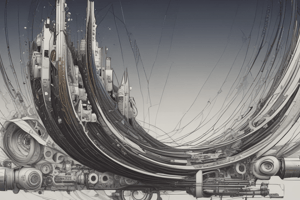Podcast
Questions and Answers
¿Qué rama de la física se encarga del estudio de la estática?
¿Qué rama de la física se encarga del estudio de la estática?
- Termodinámica
- Cinemática
- Estática (correct)
- Dinámica
¿Qué es un equilibrio estático?
¿Qué es un equilibrio estático?
- Un estado en el que un objeto acelera constantemente.
- Un estado en el que un objeto se mueve a una velocidad constante.
- Un estado en el que un objeto está en reposo sin ninguna fuerza neta actuando sobre él. (correct)
- Un estado en el que un objeto experimenta una fuerza neta hacia abajo.
¿Qué es una estructura?
¿Qué es una estructura?
- Un sistema que no está en equilibrio
- Un material bajo carga estática o dinámica (correct)
- Un sistema con aceleración
- Un objeto en movimiento
¿Qué son las fuerzas?
¿Qué son las fuerzas?
¿Qué significa que un objeto esté en equilibrio estático desde el punto de vista de las fuerzas?
¿Qué significa que un objeto esté en equilibrio estático desde el punto de vista de las fuerzas?
¿Qué tipo de cargas estudia la mecánica estructural?
¿Qué tipo de cargas estudia la mecánica estructural?
¿Qué es la fricción?
¿Qué es la fricción?
¿Qué función cumple la fricción en nuestras vidas diarias?
¿Qué función cumple la fricción en nuestras vidas diarias?
¿Qué son las fuerzas internas dentro de un sistema?
¿Qué son las fuerzas internas dentro de un sistema?
¿Por qué es importante el cálculo de las tensiones en materiales en el análisis estructural?
¿Por qué es importante el cálculo de las tensiones en materiales en el análisis estructural?
¿Cómo afectan las fuerzas internas el comportamiento de los fluidos y gases?
¿Cómo afectan las fuerzas internas el comportamiento de los fluidos y gases?
Flashcards are hidden until you start studying
Study Notes
Statics
Statics is the branch of physics that deals with the study of statics. It focuses on understanding how objects move through space and the interactions between different physical quantities like mass, force, acceleration, work, energy, power and their relationship towards each other.
Forces
Forces refer to any interaction that can change the motion of an object. They come from the outside world, like gravity pulling you down, or they result from your own actions, such as pushing against a wall. For example, if you push on something, it will experience a force equal in strength to the push, but in the opposite direction.
Equilibrium
Equilibrium is a state where all parts of an extended object are moving at constant velocity relative to some frame of reference. An object is considered to be in static equilibrium when it is both statically stable (which means it would remain stationary) and it does not have any torque acting on it. If an object is at rest and has no net external force acting upon it, it is said to be in static equilibrium. This occurs because there is no net force acting on the object.
Structures
Structural mechanics is a subject of civil engineering that studies the functional behavior of structures and building materials under the action of loads such as dead load, live load, wind load and earthquake load. In structural analysis, engineers determine how much weight a structure can hold before collapsing by calculating the stresses on the materials involved.
Friction
Friction refers to the resistance that one surface or material experiences when moved over another. When two surfaces rub together, they create heat and wear. Friction is what keeps our feet on the ground while running, helps us stop quickly, and prevents a car tire from spinning out of control. Without friction, we wouldn't be able to walk or drive cars.
Internal Forces
Internal forces within a system occur when individual particles interact with each other, causing the particles to move around and exert pressure on each other. These forces are responsible for the movement of fluids and gases, as well as the way solids behave when compressed.
Studying That Suits You
Use AI to generate personalized quizzes and flashcards to suit your learning preferences.





